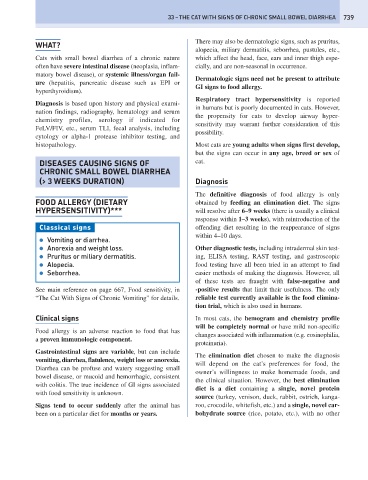Page 747 - Problem-Based Feline Medicine
P. 747
33 – THE CAT WITH SIGNS OF CHRONIC SMALL BOWEL DIARRHEA 739
There may also be dermatologic signs, such as pruritus,
WHAT?
alopecia, miliary dermatitis, seborrhea, pustules, etc.,
Cats with small bowel diarrhea of a chronic nature which affect the head, face, ears and inner thigh espe-
often have severe intestinal disease (neoplasia, inflam- cially, and are non-seasonal in occurrence.
matory bowel disease), or systemic illness/organ fail-
Dermatologic signs need not be present to attribute
ure (hepatitis, pancreatic disease such as EPI or
GI signs to food allergy.
hyperthyroidism).
Respiratory tract hypersensitivity is reported
Diagnosis is based upon history and physical exami-
in humans but is poorly documented in cats. However,
nation findings, radiography, hematology and serum
the propensity for cats to develop airway hyper-
chemistry profiles, serology if indicated for
sensitivity may warrant further consideration of this
FeLV/FIV, etc., serum TLI, fecal analysis, including
possibility.
cytology or alpha-1 protease inhibitor testing, and
histopathology. Most cats are young adults when signs first develop,
but the signs can occur in any age, breed or sex of
DISEASES CAUSING SIGNS OF cat.
CHRONIC SMALL BOWEL DIARRHEA
(> 3 WEEKS DURATION) Diagnosis
The definitive diagnosis of food allergy is only
FOOD ALLERGY (DIETARY obtained by feeding an elimination diet. The signs
HYPERSENSITIVITY)*** will resolve after 6–9 weeks (there is usually a clinical
response within 1–3 weeks), with reintroduction of the
Classical signs offending diet resulting in the reappearance of signs
within 4–10 days.
● Vomiting or diarrhea.
● Anorexia and weight loss. Other diagnostic tests, including intradermal skin test-
● Pruritus or miliary dermatitis. ing, ELISA testing, RAST testing, and gastroscopic
● Alopecia. food testing have all been tried in an attempt to find
● Seborrhea. easier methods of making the diagnosis. However, all
of these tests are fraught with false-negative and
See main reference on page 667, Food sensitivity, in -positive results that limit their usefulness. The only
“The Cat With Signs of Chronic Vomiting” for details. reliable test currently available is the food elimina-
tion trial, which is also used in humans.
Clinical signs In most cats, the hemogram and chemistry profile
will be completely normal or have mild non-specific
Food allergy is an adverse reaction to food that has
changes associated with inflammation (e.g. eosinophilia,
a proven immunologic component.
proteinuria).
Gastrointestinal signs are variable, but can include
The elimination diet chosen to make the diagnosis
vomiting, diarrhea, flatulence, weight loss or anorexia.
will depend on the cat’s preferences for food, the
Diarrhea can be profuse and watery suggesting small
owner’s willingness to make homemade foods, and
bowel disease, or mucoid and hemorrhagic, consistent
the clinical situation. However, the best elimination
with colitis. The true incidence of GI signs associated
diet is a diet containing a single, novel protein
with food sensitivity is unknown.
source (turkey, venison, duck, rabbit, ostrich, kanga-
Signs tend to occur suddenly after the animal has roo, crocodile, whitefish, etc.) and a single, novel car-
been on a particular diet for months or years. bohydrate source (rice, potato, etc.), with no other

